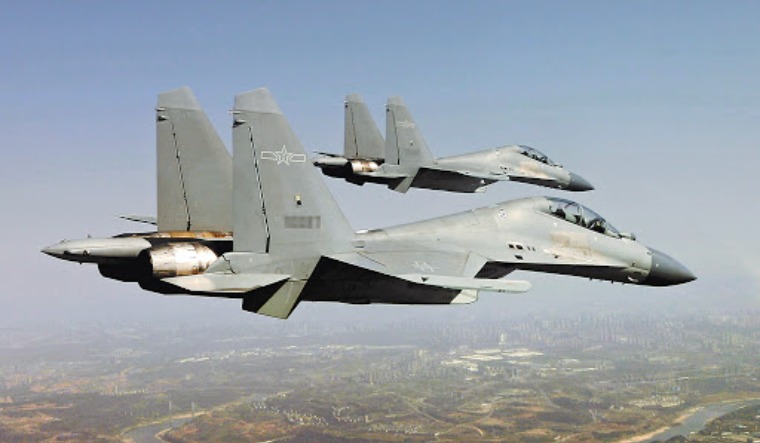China's wide-ranging military modernisation, which began in the early 1980s, has alarmed experts for a number of reasons.
While threats to its neighbours have been an obvious concern, experts have also been worried about China's use of espionage and reverse-engineering to modify its home-built weapons.
Arguably, the most visible example of China's use of reverse-engineering has been its work on the Russian Su-27 air superiority fighter, designed by the Sukhoi aircraft design bureau. China was the first export customer of the Su-27, which forms the basis of numerous aircraft such as the Su-30 multi-role fighter, Su-34 light bomber and Su-35 multi-role fighter.
The derivative fighters are all heavier than the Su-27 and can carry additional weapons, including missiles and bombs for ground attack. The Su-35 is the most advanced member of the Su-27 ‘family’, given its electronics and advanced engines that give it considerable agility in a dogfight. The most important fighter, in terms of numbers, in the Indian Air Force is the Su-30MKI, an aircraft that traces its lineage to the Su-27 design. The Indian Air Force operates over 240 Su-30MKI fighters.
Since receiving its first Su-27 jets in 1992, China has developed multiple derivatives of the aircraft indigenously. In the late 1990s, China purchased the Su-30 multi-role fighter from Russia and in 2015, it became the first export buyer of the Su-35.
According to data from 2019 from the International Institute for Strategic Studies (IISS), China was estimated to have over 600 fighters derived from the Su-27. These include the 'J-11' series, which are based on the original Russian design. The most advanced indigenous fighter that China has developed from the Su-27 family is the J-16, which experts have claimed is a copy of the Su-30 design.
The J-16 is believed to have first flown in 2011-12 and according to IISS, China had built at least 90 J-16 fighters by 2019. According to a 2020 report of UK think tank Royal United Services Institute, the J-16 is “currently China’s most capable multirole and strike aircraft". RUSI noted the J-16 features a advanced electronically scanned array (AESA) radar, which allows it to track both aerial and surface targets simultaneously. The J-16 is also thought to use more carbon composites in its construction to reduce its weight and has a 'glass cockpit', replacing dials found in older Russian jets.
Earlier this week, Chinese state media quoted a serving officer of the People's Liberation Army Air Force (PLAAF) as claiming the J-16 had "no flaws because it is equipped with many types of weapons and can operate under all weather conditions".
Wang Songxi, a flying instructor at the People's Liberation Army Northern Theater Command Air Force, was quoted by Global Times as saying, "In terms of performance, the J-16 is a superior to all types of aircraft I have flown..." He claimed the J-16 had "huge breakthroughs in radar and fire control systems in comparison with previous aircraft".
Wang claimed that though the J-16 and Su-30 look similar outwardly, "many things are different from the inside" and "there is a gap that makes the J-16 a generation more advanced than the Su-30".
Jiang Jiaji, another decorated PLAAF pilot, was quoted by Global Times as saying the J-16 has better stealth capability. Jiang claimed the J-16 is "now covered with silver-gray painting, which makes it less visible to the naked eye and electromagnetic devices".
The report on the J-16’s prowess by Chinese state media may reek of propaganda and hyperbole, given China’s continuing struggles to develop reliable engines for its fighter aircraft. In 2015, when the deal for Su-35 jets was announced, analysts warned China was eyeing reverse-engineering of the aircraft’s engines and infra-red sensors that are used to detect enemy aircraft.
also read
- Typhoon Ragasa: Southern China braces for the worst as 'king of storms' makes landfall
- Where is Typhoon Ragasa heading? 2 million evacuated in China's southern province as storm makes landfall today
- OPINION | How India–China rapprochement could be a catalyst for industrial revival
- China points out the ‘truth’ to New York Times for its Charlie Kirk disinformation report: ‘You are the problem’
However, some experts have warned that Beijing is indeed marching ahead of Russia in many areas of aircraft development. For instance, the RUSI report from last year noted China's use of datalinks for communication and improved electronic warfare capabilities gave jets such as the J-11 series and J-16 an advantage over Russian-origin fighters.
The RUSI report also cited China's considerable advances in development of air-to-air missiles and stealth technology. RUSI noted that "Russian industry has suffered from a lack of high-end micro-electronic components since the imposition of Western sanctions in response to the annexation of Crimea." On the other hand, China's use of espionage and its status as a major industrial power and hub of innovation has seen advances in development of 'dual use' electronics that have relevance in military use.




